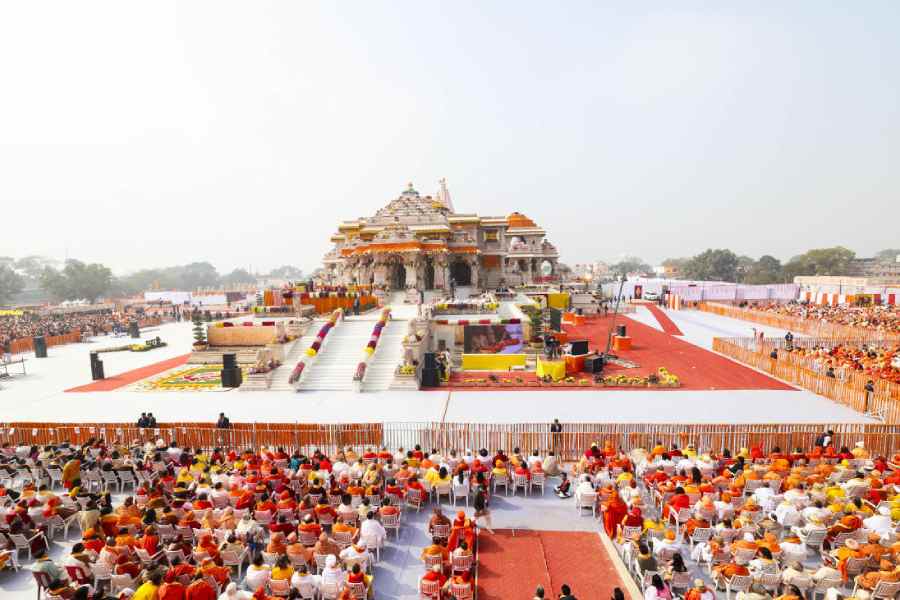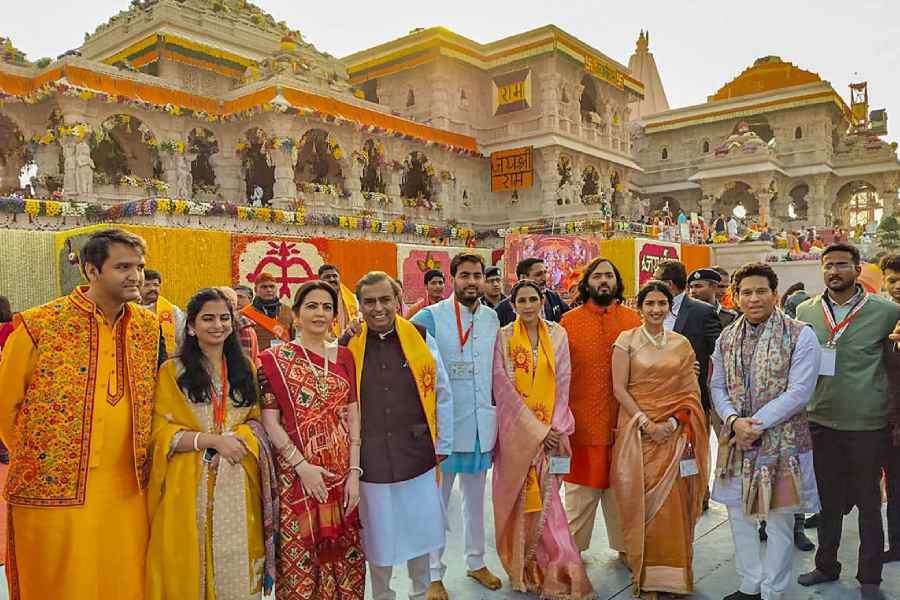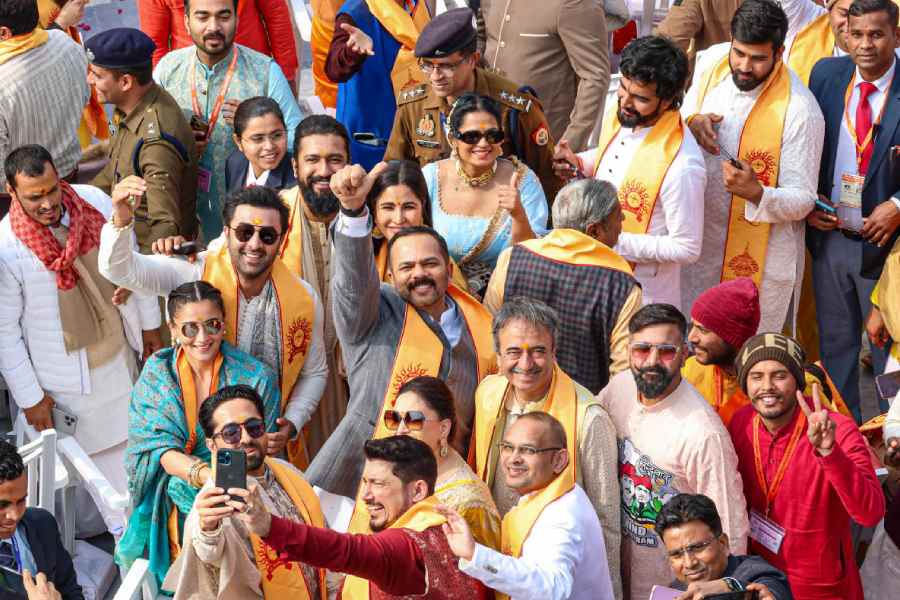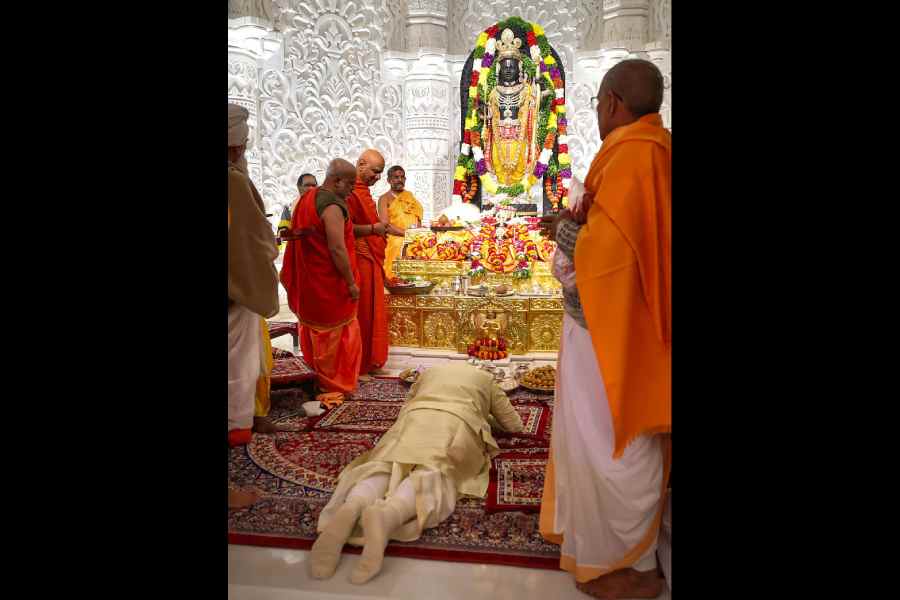On August 5, 2020 — amidst the deathly rampage of Covid-19 — Prime Minister Narendra Modi audaciously revealed to the nation from Ayodhya the chronicle of a future foretold.
Shortly past noon at the same stage on Monday, Modi concluded — to a populace awash in celebration — his telling. And doing so, he unveiled the absolute amalgamation of Church and State, a devotee nation whose decreed chief deity should henceforth be Ram.
It may not be entirely moot what this stimulation of religious giddiness means for the 2024 general election; the BJP’s numerical fortunes have clearly profited from its spearheading of the Ramjanmabhoomi movement over past decades. Under Modi the shoring up of sentiment, and its electoral translation, have become as robust a project as it is unabashed.
As he walked to the consecration rituals at a spanking Ramjanmabhoomi Temple this afternoon — in off-white silks and solitary, as his cameras often direct him to be — Modi wore the aura of raja and rishi combined.
When he spoke much later, having presided, mahant-like, over the Pran Pratistha rituals of the Ram Lalla idol under the central dome, it was often not clearly manifest that he was also elected head of a secular and vastly pluralist country, and that he not only swore allegiance to a secular Constitution but, on occasion, also respectfully placed his forehead to it.
“This is not just a divine temple, it is a temple of India’s vision, philosophy and direction,” Modi said, during a well-deliberated discourse that lasted a little more than half an hour. “It is a temple of national consciousness in the form of Ram.”

Gathering at the consecration ceremony of Ram Temple, in Ayodhya, Monday. PTI picture
He proceeded, thereon, to pronounce upon his countrywide audience, what sounded like a new ethic and ethos he’d have the nation adopt. “Ram is the faith of India, the foundation of India. Ram is the thought of India, the law of India. Ram is the consciousness of India, the contemplation of India. Ram is the prestige of India, the might of India. Ram is the flow, Ram is the influence. Ram is the norm and Ram is the policy.”
It would seem an understatement to call the invited league of celebrities and sadhus gathered before him merely “Ram-maya”, or suffused with Ram. So too of some of the scenes of heady festivity that popped in from far and near quarters of the country, Calcutta included.
The Prime Minister did refer to the Constitution in the Ayodhya context, but only as attestation of faith. “In India’s Constitution, in its first copy, Lord Ram is present. Even after the advent of the Constitution, legal battles over the existence of Lord Shri Ram continued for decades,” Modi said. “I express my gratitude to the judiciary of India, which upheld the dignity of justice. The temple of Lord Ram, synonymous with justice, was also built in a judicial manner.”
It perhaps deserves mention that in unanimously granting the once-disputed site at Ayodhya for the purposes of the Ram Janmabhoomi Temple, the Supreme Court also called the demolition of the Babri Masjid on December 6, 1992, an “egregious violation of the rule of law”.
But in truth, the political stewing around Ayodhya began far before the BJP, or Narendra Modi, came anywhere close to power. It was in 1986, when Rajiv Gandhi was Prime Minister on the heftiest Lok Sabha majority ever awarded by the electorate, that the locks on the then Babri Masjid were undone and a local court allowed Hindu worshippers into the three-domed mosque where congregational namaz had ceased to take place.
In 1989, even while the title suit to the disputed 2.77 acres of land was in the Uttar Pradesh courts, the VHP performed the shilanyas rites of the would-be temple at an adjacent site. It was a widely contested and widely reported event, seen by many as a portent to what lay in the future.
Rajiv Gandhi was learnt to have been keen to participate in the shilanyas, but was persuaded to amend his intention. V.P. Singh had revolted by then, the government’s move to placate the Muslim clergy on the Shah Bano case had stirred up anger against alleged appeasement, Rajiv’s seat was shaken. He did, eventually, arrive in Faizabad, Ayodhya’s twin town, to launch his 1989 Lok Sabha campaign and promised “Ram rajya”. Much in vain, of course.
Ayodhya was a card, often waved or pushed, for political profit. It has travelled a long way since and become an emblazoned billboard that is unembarrassed about proclaiming Narendra Modi, an elected Prime Minister of constitutionally secular India, as Hindu hriday samrat.

Mukesh D. Ambani, Chairman and Managing Director, Reliance Industries Limited and Nita M. Ambani, Founder and Chairperson, Reliance Foundation with their family and cricket legend Sachin Tendulkar, during Pran Pratishtha ceremony at Ram Mandir in Ayodhya. PTI photo
But Modi wouldn’t have arrived here without the political astuteness and labours of Lal Krishna Advani, or even the skilled and relatively unabrasive sentiment-building by Murli Manohar Joshi. Both witnessed, first-hand, the demolition of the Babri Masjid; neither was encouraged to be in Ayodhya today, or at the ground-breaking ceremonies in August 2020.
The central star of both stages was Narendra Modi, the man who played dutiful major domo to the crusades Advani triggered following the Palampur Resolution of 1989, which made the construction of a Ram temple at the site of the Babri Masjid the arrowhead of the BJP’s objectives.
The Advani-led “Ram-Rath” campaigns swelled the BJP’s popularity but left the nation riven and incensed along barbed communal fences as never after the Partition. Thousands were killed along flashpoints that opened in the wake of Advani’s yatras, or were sparked by its flaming temper. Hinduism acquired the menace-edge and militancy of Hindutva; the kindly greeting of “Jai Siya Ram” morphed into the “Jai Shri Ram” war cry, although Modi himself has been signalling a return to “Jai Siya Ram” and “Jai Siyapati Ram”.

Directors Rohit Shetty and Rajkumar Hirani with actors Ranbir Kapoor, Alia Bhatt, Vicky Kaushal, Katrina Kaif, Madhuri Dixit Nene and others at the Ram Mandir during the 'Pran Pratishtha' ceremony PTI picture
The Ramjanmabhoomi movement ignited a seminal moment in a secular nation’s lives and times. It shook the belief systems of society and politics, it echoed belligerently from the legislatures to the courthouses, it rent India’s streets bloodied, its populace rekindled with medieval bitterness and loathing. The day the cynically gathered mob at Ayodhya razed the Babri Masjid, in brazen violation of political pledge and underwritten guarantees to the Supreme Court, many deemed it the nation’s second Partition.
The Ramjanmabhoomi movement, Modi has in the past also likened to the Independence movement led by Mahatma Gandhi. He has omitted to mention that Gandhi’s was a painstakingly inclusive mission that brought all manner of Indians together to the common purpose of sending off an imperial regime. Today, Monday, January 22, 2024, sounded like the foundation rite of a nativist one.










